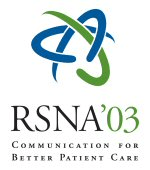Abstract:
HTML
Purpose: To determine the concordance of MR imaging with surgery regarding extent of glenoid labral tear.
Methods and Materials: Pre-operative MR exams of 17 patients (16M:1F, age range 17-39, avg 24) with arthroscopically documented glenoid labral tear were evaluated. At surgery the location and extent of labral tear was recorded relative to the glenoid margin using a clockface designation, with 12:00 representing the biceps anchor; twelve segments were recorded for each patient corresponding to hours on the clockface (superior labrum defined as 11:00-1:00; anterior, 2:00-4:00; inferior, 5:00-7:00; posterior, 8:00-10:00). Blinded to surgical findings, two radiologists separately evaluated MR images, noting location and extent of labral tear using the same designation. Two criteria were applied: a morphologic criterion (abnormal shape of the labrum) and fluid criterion (fluid extending into or under the labrum, excluding normal variation); extent using these criteria were recorded separately. Comparison was made with surgical findings.
Results: At surgery, labral tear involved the superior labrum in 16, anterior labrum in 9, inferior labrum in 9 and posterior labrum in 8; more than one quadrant was involved in 14/17 (82%). Location of tear on MR images overlapped the surgical location in 17/17 (100%) for reviewer 1 and 15/17 (88%) for reviewer 2. Using the 12 segment designation, an average of 4.3 segments were torn at surgery. On MR images, reviewer 1 / 2 recorded labral tear involving an average 5.9 / 7.1 using morphologic criterion and 4.5 / 5.3 using fluid criterion. Concordance with segments involved at surgery was 82% / 88% using morphologic criterion and 71% / 70% using fluid criterion. On MRI, reviewer 1 / 2 interpreted tear as more:equal:less extensive than surgery in 13:3:1 / 14:0:3 using morphology and 5:7:5 / 11:1:5 using fluid criterion.
Conclusion: MR imaging has a high concordance with surgery regarding extent of glenoid labral tear although it is most commonly overestimated, especially when using abnormal morphology rather than fluid signal as the criterion.
Questions about this event email: william.morrison@mail.tju.edu
Morrison MD, W,
Accuracy of MR Imaging for Evaluation of Extent of Glenoid Labral Tear. Radiological Society of North America 2003 Scientific Assembly and Annual Meeting, November 30 - December 5, 2003 ,Chicago IL.
http://archive.rsna.org/2003/3107870.html

